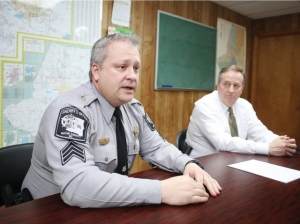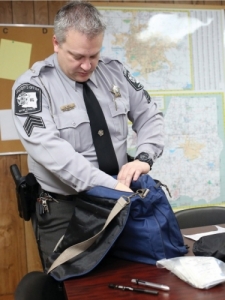Task force to help reduce drunk driving in county
By John Joyce
Published in News on February 4, 2016 1:46 PM

News-Argus/CASEY MOZINGO
Sgt. Jayson Hill with the Wayne County Sheriff's Office talks about the new DWI Task Force that was formed in October of 2015. The team, made up of Hill and three additional deputies, is 100 percent funded for its first year.

News-Argus/CASEY MOZINGO
Sgt. Jayson Hill unpacks a bag containing items used for testing after a DWI suspect has failed the field sobriety test. Items include a flashlight, UV light, blood pressure cuff and other items used to test the effects of drugs and alcohol on the body.
Wayne County has a problem with drunken drivers.
In 17 of 26 categories ranking each county in terms of traffic safety, Wayne County falls in the top 25, according to statistics kept by the N.C. Governor's Highway Safety Campaign.
Among the categories are alcohol-related fatalities.
"In 2014, I believe we were ranked 16th in the state with alcohol-related fatalities. And that is, someone died in a vehicle crash where alcohol was a factor in the crash," Sgt. Jayson Hill said.
Hill is the sergeant in charge of the Wayne County Sheriff's Office DWI Task Force, formed in October of 2015 to combat the number of motorists getting behind the wheel after consuming alcohol.
Hill and three deputies comprise the task force, financed by a federally funded grant dispersed through the GHS campaign.
"In our first quarter, we stopped 570 cars. We arrested 555 of those drivers for DWI," Hill said.
The task force operates mostly during nights and weekends, patrolling most heavily in "high DWI corridors," or areas where the task force has found there are a high number of impaired drivers driving through that area.
"It's the nature of the beast, but it's going to be where the alcohol is sold," Hill said. "They're going to be coming from clubs and bars and stuff like that."
And that is not to pick on specific clubs or bars, he assured. But an effort to take intoxicated drivers off the road is most likely to be successful in areas where alcohol is being sold, he said.
The task force began with more than $469,000 in grant money, which funded 100 percent of the cost for the first year, including salaries and equipment purchases.
"In its second year, it steps down to 85 percent funding, which is just the salaries," Hill said. "Since all the equipment has already been bought."
The rest of the cost is shouldered by the county, he said.
In addition to increasing patrols and conducting checkpoints and saturation campaigns during holiday weekends and whenever there is an ongoing GHS campaign, such as Booze It and Lose It, the task force is also rolling out an educational program targeting young people.
Hill said the program, which is still being put together, will aim at teaching 16- to 21-year-olds about the dangers of driving while impaired.
Hill said the average person arrested for DWI has driven intoxicated a thousand times prior to getting caught.
"A high majority of the (DWI charges) we get have been charged previously," Hill said. "A lot of them more than once."
Introducing education and prevention programs for young people will hopefully cut down on those numbers. A lot of first-time offenders are younger, he said.
"And that's just because they haven't had enough time. But they are on that same path," Hill said.
Hill, a 13-year veteran of the sheriff's office, has three deputies under him assigned to the task force -- a corporal and two deputies. With three, five and seven years experience, respectively, the deputies know what signs to look for while patrolling county roads for impaired drivers.
In addition, each task force member has completed an extensive six-month course, including specialized DWI enforcement, and three of whom have become certified Drug Recognition Experts (DREs).
There are seven different drug categories, each with unique signs and symptoms a user will present, Hill said.
Driving while impaired by drugs can be as dangerous as drinking and driving. What is worse is when a driver mixes both drugs and alcohol.
"Marijuana is big and narcotics -- heroin, oxycodone, prescription pills, such as that," Hill said. "And then your more common anti-anxiety pills, Xanax, stuff like that."
Hill said a person legally prescribed a drug can still be charged with DWI if driving while impaired by the substance.
"A lot of times, if you'll look on the side of your prescription bottle, it will say don't drive or operate heavy machinery while taking this medication," he said.
The task force has encountered some such cases, but more often than not the majority is abuse, Hill said.
Regardless of the substance, an impaired driver presents a risk to themselves and to others.
Hill takes his job seriously, he said, because removing impaired motorists from the roadway saves lives.
"My biggest thing is, my family is out there on the road. Your family is out there," Hill said. "I want to remove as many as I can."
